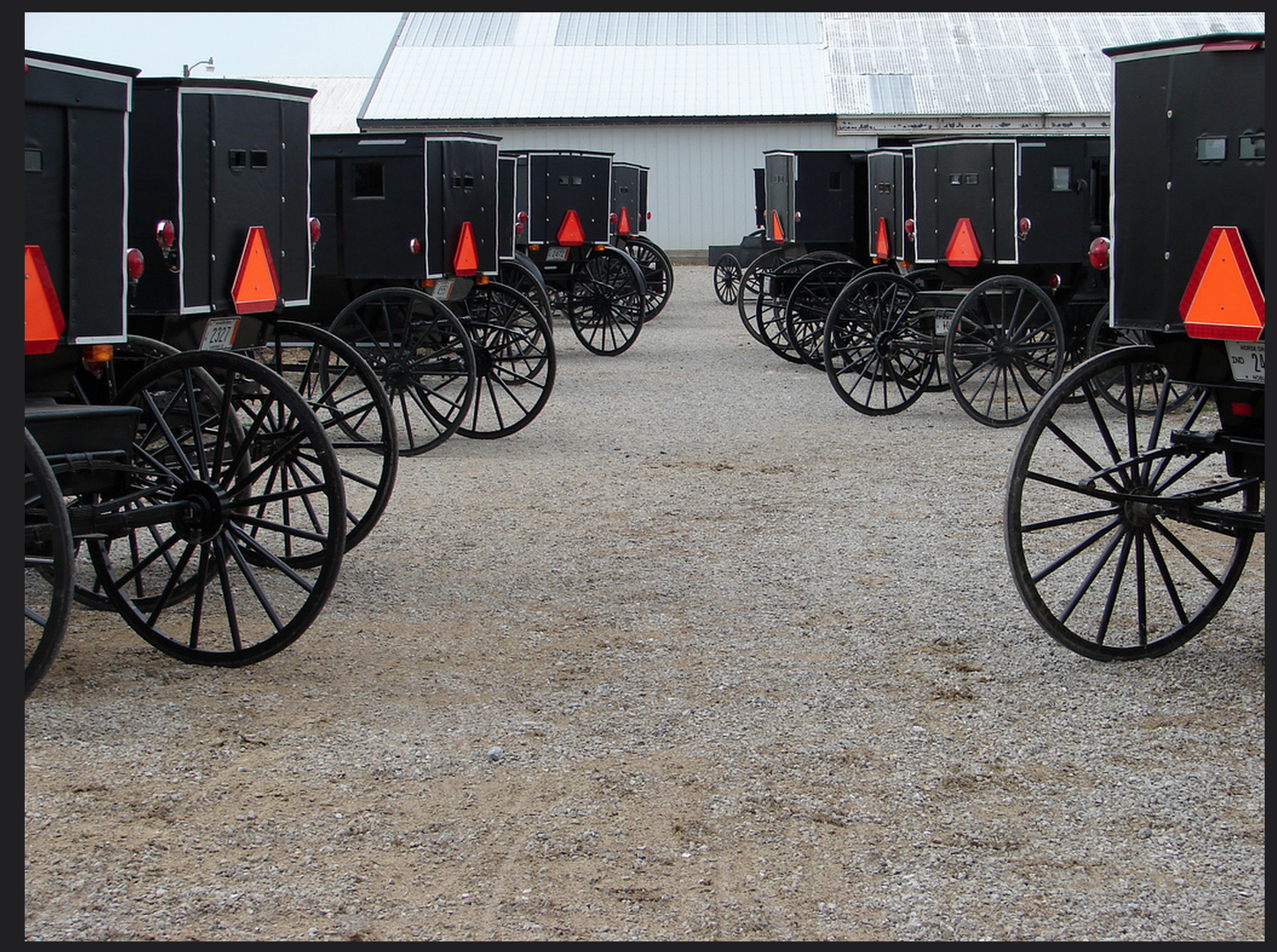
Everything You Want to Know About Amish Beliefs
We’re so pleased to welcome Erik Wesner back to the blog! Today, he tells you a bit about the rather intriguing and sometimes confusing realm of Amish beliefs. Take it away, Erik!
While Amish society is more diverse than you might think—with some Amish being more progressive and others more conservative—there are a number of core beliefs which all share in common.
Here are five key beliefs of the Amish:
1. Adult baptism

The word ‘Anabaptist’ was originally a derogatory term meaning “rebabptizer”
Amish believe that the decision to be baptized into the church should be made by adult individuals. Typically the Amish are baptized between the ages of 18 and 22, though baptism may occur earlier or later.
Baptism is ostensibly a free choice, and you might be surprised to learn that the majority of Amish youth choose to be baptized in the faith of their parents (depending on the community, this ranges anywhere from two-thirds to over 90% of all youth).
Desire to practice adult baptism played a critical role in the genesis of the Anabaptist* movement, in contrast to the infant baptism practiced at the time.
*Anabaptism is the name given the larger 16th-century movement from which the Amish emerged, and which related churches including Mennonites and Hutterites can also trace their spiritual heritage. The word was originally a derogatory term meaning “rebaptizer” but does not carry a negative connotation today.
2. Nonresistance

“Resist not evil, but whoever shall smite thee on thy right cheek, turn to him the other also” (Matthew 5:39).
This fundamental belief is rooted in The Sermon on the Mount, found in the Gospel of Matthew. Jesus admonishes his followers to “resist not evil, but whoever shall smite thee on thy right cheek, turn to him the other also” (Matthew 5:39).
It’s important to note that for the Amish, nonresistance takes on greater meaning than just an anti-war stance of pacifism. Nonresistance means opposing military action, but it also extends into other areas of life.
For example, Amish are against doing violence against others, even in self-defense. In this area, Amish take inspiration from the many examples of Anabaptist martyrs before them.
Furthermore, the Amish oppose wielding other, more abstract forms of force, including legal power (thus they refrain from filing lawsuits) or the power of the state (as a result the Amish do not hold political office, or serve as law enforcement).
3. Separation from the world

One oft-cited passage regarding the Amish belief in separation from the world is found in 2 Corinthians 6:14 – “Be ye not unequally yoked together with unbelievers: for what fellowship hath righteousness with unrighteousness? and what communion hath light with darkness?”
Amish have been described as “a people apart”. To the casual observer, many things about their lifestyle do seem sharply removed from the flow of modern society.
One oft-cited passage regarding the Amish belief in separation from the world is found in 2 Corinthians 6:14 – “Be ye not unequally yoked together with unbelievers: for what fellowship hath righteousness with unrighteousness? and what communion hath light with darkness?”
The principle inspired by these words manifests itself in a variety of ways. One example is found in Amish refusal to participate in commercial insurance programs. Rather, church members support one another in times of need, while some communities have more formal private insurance programs.
Another obvious marker of separation is the wearing of plain dress. Amish also generally live in rural areas away from cities and population centers, and at least until recent generations, they have traditionally favored occupations which minimized worldly contact (farming).
Yet though the Amish profess a belief in separation from the world, in practice Amish have many ties and interactions with the rest of us.
Many have non-Amish friends, do business with non-Amish people, and may travel to cities for business or sometimes recreational purposes (for example, to visit a museum or historic site). The way the separation principle is expressed can vary across Amish groups, with the more conservative Amish churches generally remaining more physically and/or symbolically separate.
4. Social Shunning

Shunning only occurs when a member is excommunicated for breaking church rules (known as the Ordnung) or committing serious sin, and refusing to change one’s behavior.
Amish feel social shunning is a Biblically-mandated practice which they are obligated to uphold for the spiritual good of their fellow brethren. They base this practice in multiple passages including 1 Timothy 5, Matthew 18, and 2 Thessalonians 3:14. Notably, shunning was one of the key points of contention which led founder of the Amish Jakob Ammann to instigate a schism within the Swiss Brethren in 1693.
Shunning can be described as altered social behavior towards an excommunicated church member. In practice this can mean a few things: not doing business with an excommunicated person, not eating together in certain situations, and not accepting material aid from an excommunicated individual (though assistance will be given from church members to the excommunicated person).
Shunning only occurs when a member is excommunicated for breaking church rules (known as the Ordnung) or committing serious sin, and refusing to change one’s behavior. It only applies to church members—not the unbaptized, or non-Amish people.
Despite what you may have heard, this is not a step taken lightly. Amish lay members and ministry attempt to convince an errant brother to mend his ways and return to the fold before taking the serious step of holding a church vote on excommunication. One Amishman says that such steps are taken with “great reluctance.”
It’s important to note that shunning is not permanent so long as the individual ceases the offending behavior and confesses transgressions to the church. The occasions when excommunicated do return have been described by the Amishman as bringing “a feeling of restoration.”
Though it can be imperfectly practiced, social shunning is meant to be done in a spirit of love and concern. It is intended to convince the individual to correct errant ways, confess, and return to good standing in the church (which can occur in theory at any time after excommunication, even decades later, as has happened with some individuals). Social shunning is also a tangible reminder that the baptismal commitment is taken seriously.
5. Restricted technology

Some Amish (including most of our woodworkers!) rely on community phone booths like this one over a home or business phone. This is an attempt to limit distraction from home and family in many cases.
Amish are well-known for their refusal to use, or desire to limit use of, certain technologies.
However, Amish do not feel technology is inherently evil. Rather, they wish to avoid what they see as the negative effects of technology – a potential weakening of family and community.
To take one example, Amish forbid car ownership and operation, because they feel that cars would encourage travel beyond the community and away from home, increase the pace of life, and lead to less reliance on the church and community.
Electricity is also limited: public power is not used in the home, though a wide variety of batteries are used in most churches, as well as solar power in some congregations. Why are batteries okay, but not the public utility? Public power can power any type of device, while batteries have more limited use. Additionally, there is a symbolic element to being “wired” to the outside world.
Despite these and other restrictions, Amish recognize a limited need for certain technologies. This is why, despite the ban on car ownership, they permit members to ride in cars driven by outsiders, with many Amish hiring non-Amish to drive so-called “Amish taxis”, for example.
This also explains why the Amish have come to accept a variety of different arrangements concerning the telephone. Some Amish may have a phone in a business building. Others will share a community phone with other families, located in a small building usually near the roadside.
In some communities, cell phones are even used (though that device has been controversial). However, the vast majority of Amish do not install the phone in the home, as they see it as a disruption to family life—as well as, like the electric line, a symbolic connection to the world.
Though their beliefs on technology may sometimes lead to some puzzling arrangements, Amish are notably thoughtful about how they use technology—probably more so than most of us. Rather than embrace every new innovation, they consider potential consequences before something is accepted, generally trying to err on the side of the good of church and community.
These aren’t the only distinct Amish beliefs. Additional Amish beliefs and religious practices stem from their faith background and core values, and include not working or doing business on Sundays, twice-yearly communion, the practice of footwashing, and home worship services (rather than in churches or meetinghouses).
Erik Wesner is the founder and blogger behind Amish America.





I so enjoy reading about the Amish..I respect their beliefs..they are family but like us all their are problems no matter what…Thank you for this information..Blessings!
You’re welcome, Kimberlee.
There is amish decent in the King family. How do we trace it?
Hi Janet.
Thank you for your question. Here are a few links that we hope will assist you in tracing your genealogy.
https://www.saga-omii.org/
https://www.ancestry.com/
Best of luck!
Love reading about the Amish thx for the website
Hi Cindy,
Thank you for reading. We’re so glad you like the content.
Such an interesting read! I’ve long been intrigued by the simplicity of Amish life and I admire the way they adhere to their basic beliefs. With so many falsehoods and speculation about those core values, it was refreshing to read your account.
I enjoyed your info about Amish beliefs. How to the Amish and their elders feel about the Amish appearing in different reality tv show? How accurate are these shows? Thank you
Hi Sandy,
Thanks for your question. It is our understanding that the reality TV shows about the Amish are not accurate. This link from Amish America is a good resource for accurate information. https://amishamerica.com/tv-shows/